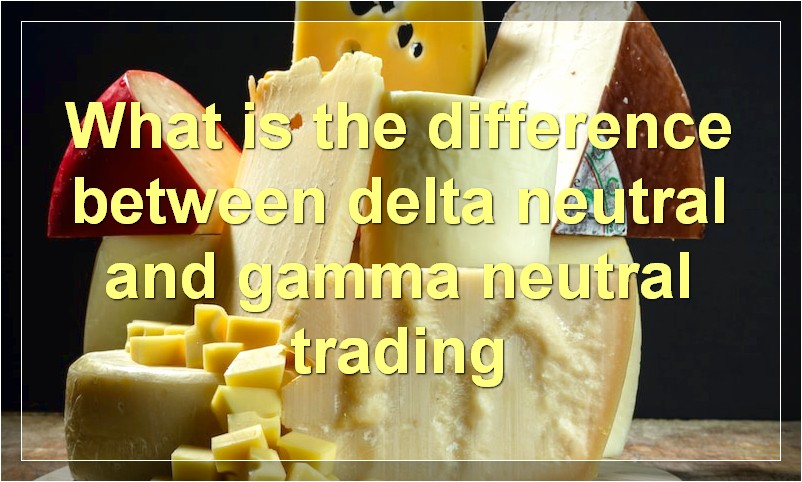If you’re looking to get started in delta neutral trading, then this is the article for you. Here we’ll cover the basics of what delta neutral trading is and how it can benefit you.
What is delta neutral
In finance, delta neutral is a portfolio consisting of various financial instruments that cancel out each other’s price movements. The net deltas of the position sum to zero, allowing the investor to be unaffected by small changes in the underlying asset’s price. This hedging technique is often used in options trading to minimize risk.
What is the purpose of delta neutral trading

Delta neutral trading is a type of trading where the trader tries to offset the risk of price movements in the underlying asset by taking opposing positions in related assets. This is done by buying and selling options with different strike prices or by using different types of options, such as puts and calls.
The purpose of delta neutral trading is to reduce the risk of losses from price movements in the underlying asset. By offsetting the risk in one asset with an opposing position in another asset, the trader can minimize the impact of price movements on their overall portfolio.
Delta neutral trading can be used to speculate on the direction of the market, or to hedge against potential losses. For example, a trader could take a long position in a stock and offset the risk of a decline in the stock price by taking a short position in an index futures contract. If the stock price falls, the trader will make money on the futures contract, offsetting some of their losses on the stock.
Delta neutral trading can be a complex and risky strategy, so it is important to understand all the risks involved before entering into any trades.
How does delta neutral trading work
In delta neutral trading, the trader seeks to offset the risk associated with price movements in the underlying asset by holding both long and short positions. This is done by buying an asset when the price is low and selling it when the price is high, or vice versa. The idea is that the gains from the winning trade will offset the losses from the losing trade, resulting in a net profit.
Delta neutral trading can be used in a variety of different situations, including when there is expected to be high volatility in the market, or when the trader wants to take advantage of a temporary price movement. In order to be successful, delta neutral traders need to have a good understanding of market dynamics and be able to quickly identify opportunities.
One of the benefits of delta neutral trading is that it limits your downside risk. By holding both long and short positions, you are effectively hedged against sudden changes in prices. This means that you are less likely to experience large losses, even if the market does move against you.
Another benefit of delta neutral trading is that it can help you to maximize your profits. If you are able to correctly predict which way the market will move, then you can make profits by taking both long and short positions. This means that you can profit from both rising and falling markets.
Delta neutral trading is not without its risks, however. One of the biggest dangers is that you could end up with a large loss if the market moves sharply against you. This is why it is important to have a good understanding of market dynamics before attempting this type of trading.
What are the benefits of delta neutral trading
Delta neutral trading is a type of trading where the trader does not have a bias towards the direction of the market. This means that the trader is not trying to predict which way the market will move, but rather is trying to take advantage of the price movement. There are several benefits to delta neutral trading, including:
-It can help to limit risk
-It can make it easier to enter and exit trades
-It can make it easier to manage your position
-It can help you to stay disciplined
-It can lead to higher profits
What are the risks of delta neutral trading
When trading options, delta neutral strategies involve the purchase of both a put and a call option on the same underlying security with the same expiration date. The options are bought and sold in equal quantities so that the trade is delta neutral. That is, the position does not gain or lose money if the underlying security moves up or down by a small amount.
However, there are risks associated with delta neutral trading. First, because the trade is based on two options, it is more expensive than buying just one option. Second, if the underlying security moves sharply in either direction, the trade can lose money. Finally, delta neutral trades can be difficult to execute if there is not enough liquidity in the market.
What is the difference between delta neutral and gamma neutral trading

When it comes to trading, there are two main types of neutrality that traders can aim for: delta neutrality and gamma neutrality. Both have their own advantages and disadvantages, so it’s important to understand the difference between the two before making any decisions.
Delta neutrality is all about having no directional bias in your trading. This means that you’re not looking to profit from any particular direction in the market, but rather from the volatility itself. To achieve delta neutrality, you need to make sure that your long and short positions are equal in value. This can be a difficult task, as it requires constant monitoring and adjustment in order to keep things balanced. However, delta neutrality can be a great way to trade if you’re comfortable with managing your positions on a regular basis.
Gamma neutrality, on the other hand, is all about having no exposure to changes in the underlying asset’s price. This means that you’re not looking to make money from price movement, but rather from the time decay of options contracts. Gamma neutrality can be achieved by holding both long and short positions in equal amounts. This strategy is often used by traders who are looking to hedge their portfolios against sudden market moves.
So, which is best for you? Delta neutrality or gamma neutrality? There’s no right or wrong answer – it all depends on your individual trading style and goals. If you’re comfortable with managing your positions regularly, then delta neutrality might be the way to go. If you’re more interested in hedging your portfolio against market moves, then gamma neutrality could be a better option. Ultimately, it’s up to you to decide which approach suits your needs best.
What is the difference between delta neutral and long/short straddles
When it comes to options trading, the terms “delta neutral” and “long/short straddle” are often used interchangeably. However, there is a big difference between the two strategies.
A delta neutral strategy is one where the trader is not concerned with the direction of the underlying asset. They simply want to take advantage of the volatility in the market. To do this, they would buy an equal number of put and call options with the same strike price and expiration date. This way, no matter which way the asset moves, they will make money.
A long/short straddle is a bit more complex. In this strategy, the trader is looking to profit from both a rise and fall in the price of the underlying asset. To do this, they would buy a call option and a put option with different strike prices. For example, they might buy a call option with a strike price of $100 and a put option with a strike price of $90. If the price of the asset rises above $100, they will make money on the call option. If the price falls below $90, they will make money on the put option.
How do you create a delta neutral position
A delta neutral position is one where the underlying security’s price movement does not impact the position’s value. In order to create a delta neutral position, the investor must first understand the concept of delta. Delta measures how much the price of an asset will change in response to a change in the underlying security. Delta can be either positive or negative, and it is important to note that different securities have different deltas. For example, a stock with a delta of 0.5 will move $0.50 for every $1.00 move in the underlying security. Conversely, a stock with a delta of -0.5 will move $0.50 in the opposite direction of the underlying security.
Once the investor understands delta, they can then begin to construct a delta neutral position. There are a few different ways to do this, but the most common is to buy/sell the underlying security and offsetting it with an equal number of calls/puts. For example, if an investor wanted to create a delta neutral position using XYZ stock trading at $50 with a delta of 0.5, they would buy 100 shares of XYZ stock and sell 2 calls with a strike price of $50. This would create a delta neutral position because the long stock position has a delta of +50 (100 x 0.5) and the short call position has a delta of -100 (2 x -0.5). When these two positions are combined, they cancel each other out and create a delta neutral position.
How do you adjust a delta neutral position
In order to adjust a delta neutral position, you must first understand what delta is and how it affects your position. Delta is the rate of change of an option’s price with respect to the underlying asset’s price. So, if the underlying asset’s price increases by $1, the option’s delta will increase by $0.01. Conversely, if the underlying asset’s price decreases by $1, the option’s delta will decrease by $0.01.
Now that you know what delta is, you can use it to adjust your position. If your position is long delta, you want the underlying asset’s price to increase. To do this, you would buy more of the underlying asset or sell some of your options. Conversely, if your position is short delta, you want the underlying asset’s price to decrease. To do this, you would sell some of the underlying asset or buy more options.
You can also adjust your position by using different types of options. For example, if you are long call options, you can adjust your position by buying put options. This will hedges your position and make it delta neutral. There are many other ways to adjust a delta neutral position; it all depends on what your goals are and what type of options you are trading.
What are some common mistakes made when trading delta neutral
When trading delta neutral, some common mistakes include not monitoring the underlying security, not managing risk, and not staying disciplined.

